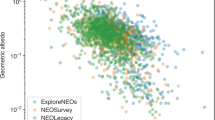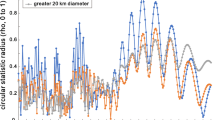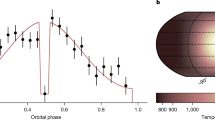Abstract
According to standard solar models, the energy radiated from the surface of the Sun is equal to that generated by purely nuclear processes in the core. In the absence of perturbations, structural changes take place only on the nuclear evolutionary time scale; for example, during the last 108 yr, the Sun's semi-diameter would be expected to have increased by ∼4 arc s (ref. 1). Claims based on meridian transit measurements that the Sun has been shrinking on a much shorter time scale2, ∼1 arc s per century−1, and thereby changing its potential energy, have been disputed and upper limits on any secular decrease have been shown to be consistent with a constant diameter3,4. Measurements made during the 31 July 1981 total eclipse, reported here, together with a re-analysis of previous eclipse and Mercury transit measurements, confirm that there is no evidence for any secular change in the solar diameter, with a reduced upper limit. However, there is increased support for an ∼80-yr cyclic variation.
This is a preview of subscription content, access via your institution
Access options
Subscribe to this journal
Receive 51 print issues and online access
$199.00 per year
only $3.90 per issue
Buy this article
- Purchase on Springer Link
- Instant access to full article PDF
Prices may be subject to local taxes which are calculated during checkout
Similar content being viewed by others
References
Iben, I. Astrophys. J. 147, 624–663 (1967).
Eddy, J. A. & Boornazian, A. A. Bull. Am. astr. Soc. 11, 437 (1979).
Shapiro, I. I. Science 208, 51–53 (1980).
Parkinson, J. H., Morrison, L. V. & Stephenson, F. R. Nature 288, 548–551 (1980).
Parkinson, J. H. Q. J. R. astr. Soc. 23, 252–255 (1982).
Duncombe, J. S. U. S. Naval Observ. Circ. No. 141 (1973).
Jones, J. E. J. Br. astr. Ass. 91, 363–367 (1981).
Gilliland, R. L. Astrophys. J. 248, 1144–1155 (1981).
Dunham, D. W., Dunham, J. B., Fiala, A. D. & Sofia, S. in Variations of the Solar Constant (ed. Sofia, S.) 117–121 (NASA CP-2191, Washington, 1981).
Hoyt, D. V. Rev. Geophys. Space Phys. 17, 427–458 (1979).
Sofia, S., O'Keefe, J., Lesh, J. R. & Endal, A. S. Science 204, 1306–1308 (1979).
Endal, A. S. & Twigg, L. W. Astrophys. J. 260, 342–352 (1982).
Gough, D. O. in Variations of the Solar Constant (ed. Sofia, S.) 185–206 (NASA CP-2191, Washington, 1981).
Lomb, N. R. & Anderson, A. P. Mon. Not. R. astr. Soc. 190, 723–732 (1980).
Author information
Authors and Affiliations
Rights and permissions
About this article
Cite this article
Parkinson, J. New measurements of the solar diameter. Nature 304, 518–520 (1983). https://doi.org/10.1038/304518a0
Received:
Accepted:
Issue Date:
DOI: https://doi.org/10.1038/304518a0
This article is cited by
-
Diameter of the Sun in AD 1715
Nature (1988)
-
Sunspot index infers a small relict magnetic field in the Sun's core
Nature (1983)
Comments
By submitting a comment you agree to abide by our Terms and Community Guidelines. If you find something abusive or that does not comply with our terms or guidelines please flag it as inappropriate.



